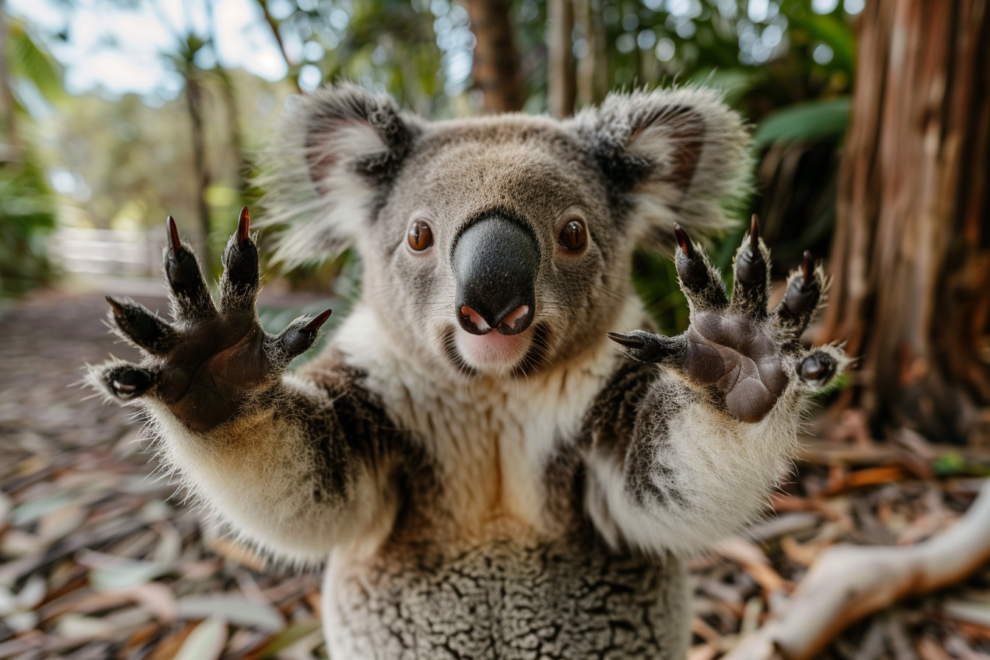You might be surprised to learn that koalas have fingerprints almost identical to humans, which evolved specifically for their unique lifestyles.
These intricate patterns on their paws help them grasp eucalyptus leaves with incredible precision, essential for their specialized diet.

Remarkably, koalas’ prints are nearly indistinguishable from human ones, a result of convergent evolution. Forensic scientists find this similarity fascinating, even though they can differentiate between the two.
The tiny ridges on koala fingerprints amplify vibrations, allowing secure branch holding and selective eating. To uncover more intriguing facts about these adorable marsupials and their fascinating adaptations, stick around.
Evolutionary Significance
Koalas’ fingerprints, which evolved due to their need to grasp eucalyptus leaves with precision, offer a fascinating example of how diet influences anatomical adaptations.
Koalas have fingerprints that are strikingly similar to humans’, an intriguing outcome of convergent evolution. This phenomenon occurs when different species evolve similar traits independently, often due to similar environmental pressures or needs.

For koalas, the specialized diet of eucalyptus leaves played a pivotal role in this development. Their picky eating habits required them to have a high degree of sensitivity and control when handling leaves, leading to the evolution of unique anatomical features like their fingerprints. These biomechanical adaptations highlight how important diet can be in shaping an animal’s physical traits.
The last common ancestor of koalas didn’t have fingerprints, suggesting that these features evolved specifically in response to their dietary needs.
The evolution of koalas’ fingerprints underscores the significance of biomechanical adaptations in facilitating specialized behaviors, such as the precise leaf-grasping necessary for their survival.
Comparison to Human Prints
In the domain of anatomical adaptations, you’ll find that koalas’ fingerprints are almost indistinguishable from human fingerprints, showcasing an extraordinary example of convergent evolution.
Both koala prints and human prints exhibit unique patterns that are so similar, you might struggle to tell them apart. This fascinating similarity arose independently in the two species, driven by different needs but resulting in remarkably alike outcomes.
Koalas developed these intricate fingerprints due to their need to grasp and manipulate eucalyptus leaves precisely.
Much like human prints, koala prints would increase the surface area on their paws, enhancing their grip. These unique patterns allow koalas to be incredibly selective eaters, ensuring they can pick and handle their food with dexterity.

The resemblance between koala and human fingerprints has intrigued scientists, especially forensic scientists. Although this topic ventures into future discussions, it’s important to acknowledge how convergent evolution has led to such surprisingly similar anatomical features in two very different species.
The next time you look at your own fingerprints, consider the incredible journey of evolution that led to koalas having fingerprints so similar to yours.
Forensic Implications
Forensic specialists have found that koala prints are so similar to human ones that, at a crime scene, it could lead to some initial confusion.
However, experts can indeed differentiate between the two. This unique characteristic even caught the attention of the London police, who were fascinated by how such an adaptation evolved in koalas.
Koala fingerprints evolved primarily as an adaptation to help them grasp eucalyptus leaves, an essential part of their dietary habits.
This evolutionary trait raises fascinating questions about the convergence of traits across different species. Imagine a scenario where forensic specialists are carefully analyzing prints at a crime scene, only to discover that some belong to a koala.
While media reports often exaggerate the potential for confusion, in reality, the experts are well-equipped to identify the subtle differences that set koala prints apart from human ones.
Thus, the study of koala fingerprints not only enriches our understanding of forensic science but also shines a light on the intricate web of evolution and adaptation.
Biomechanical Benefits
Through the intricate design of their fingerprints, koalas gain essential sensitivity that lets them grasp eucalyptus leaves with remarkable precision. This sensitivity is a key biomechanical benefit, enabling koalas to securely hold onto branches and pick just the right leaves to eat.
Their picky eating habits mean they need to be selective about their food, and their fingerprints help them achieve this with ease.
The ridges on their fingerprints amplify vibrations on rough surfaces, enhancing their sensory perception. This heightened sensitivity allows koalas to detect the texture and firmness of the leaves, ensuring they choose the most nutritious ones.
It’s a fascinating example of how specialized adaptations support their arboreal lifestyle and diet.









